Text
Napoléon III’s Imperial Trains 🚂

Emperor Napoléon III had a serious passion for railroads, seeing them as key to France's rapid modernization during the Industrial Revolution. When he crowned himself emperor in 1852, France had a modest 2,000 miles of track. But in just a few years, he dramatically expanded that to over 12,000 miles! Under Napoléon III's reign, even farmers could travel by train.
He achieved this by merging several smaller rail lines into six major companies, all centered around Paris. An each of these companies even provided the Emperor with his own dedicated train. The first imperial train arrived in 1855 from the Compagnie du Nord, followed by one in 1856 from the Compagnie Paris-Orléans, and a third in 1857 from the Compagnie de l'Est.
Train car of the imperial train of Napoleon III given by Compagnie du Nord c. 1855
Exterior:


Interesting enough this train car that Napoléon III and Empress Eugenie paraded alongside Queen Victoria. This same train car was still used during the third republic and this wagon was attached to Marshal Foch's train in 1917 and sent it in 1918 to fetch the Germans who were to sign the armistice.
If you know your history you know that the famous train car No. 2419 D, where Marshal Foch dictated the text of the armistice to the defeated Germans no longer exists, the train car that belonged to Napoléon III, still remains at the "Hameau du vin" station created by Georges Duboeuf.

The interior of Napoleon’s Ceremonial carriage of the imperial train used by Napoleon for his travels on the northern and bordering railway network. It was inaugurated for the official journey of Queen Victoria on the Boulogne-sur-Mer > Paris route on 18 August 1855.


A decorative shield on the Imperial train.
Train car of “aides-de-camp salon”, from 1856 at Mulhouse Train Museum Cité du Train.
Exterior:

These set of train-car belonged to the emperor's seven-train cars , decorated in deep red, ultramarine blue, and gilded bronze, had its first journey between Paris and Bayonne in June 1856. This personal imperial train was Commissioned by the Paris-Orléans company, it was built under the guidance of chief engineer Camille Polonceau, with its exquisite interior designed by the famous Viollet-le-Duc.

Interiors
A lounge car of Napoléon III
Interior of "aides-de-camp salon", It owes its interior design to Viollet-le-Duc.

A green velvet upholstered sofa, the color of Emperor Napoleon Ill, from the lounge car of the imperial train.
58 notes
·
View notes
Text


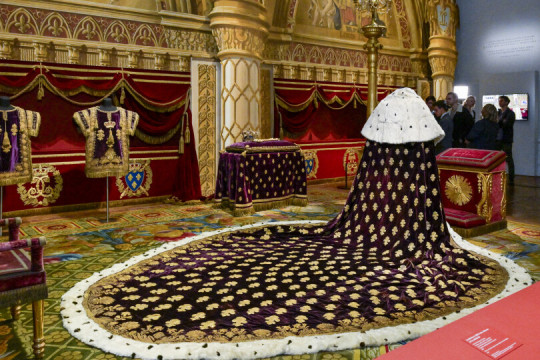
Le dernier sacre, exposition au mobilier national, sur le le sacre de Charles X en 1825.
Source photo: point de vue et l'Union
#french monarchy#french history#france#mobilier national#charles x#sacre#coronation#2025#19th century#xixe siècle#couronnement
4 notes
·
View notes
Photo
Not Marie Louise, no own care about her during the second empire. It's of course Hortense, daugther of Josephine and, most important, Mother of Napoléon III.

Lithograph representing the Imperial Family of France.
Napoleon is in the centre, with his son by Marie Louise, Napoleon II. Josephine and Marie Louise are on either side of them. In the front are Napoleon III, Empress Eugenie, and their son Napoleon Eugene, the Prince Imperial.
28 notes
·
View notes
Text

A portrait of Marie-Thérèse de France, duchesse d’Angoulême by Benoît Benjamin Bonvoison, circa 1816. Set to be auctioned by Millon.
92 notes
·
View notes
Text

Photo of French bank notes and coins, about 1862
Albumen silver print by Saint Thomas D'Aquin (French, active 1860s)
The J. Paul Getty Museum, 84.XC.873.5917
15 notes
·
View notes
Text

Bâton de maréchal de France de Louis Georges Erasme, marquis de Contades.
1758
24 notes
·
View notes
Text

Le Lioran, Cantal, 1911
Lieutenant Girard dans un de ses sauts.
36 notes
·
View notes
Text

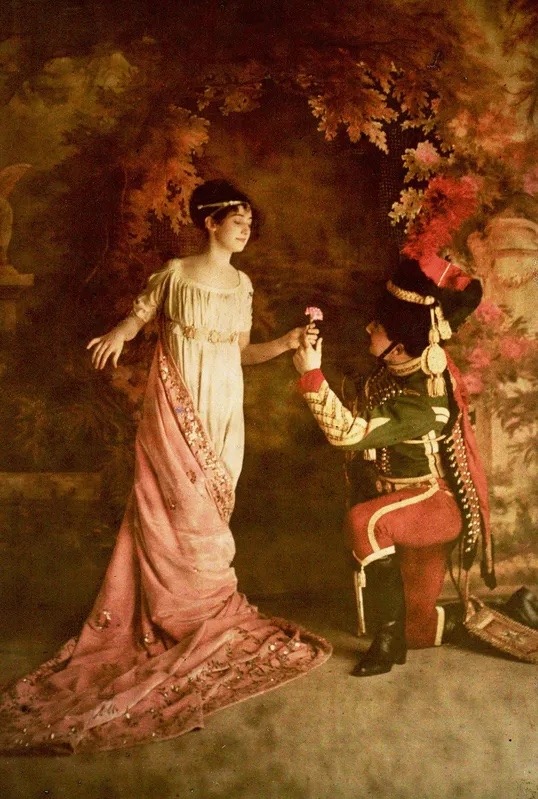
A Napoleonic Soldier Offering a Maiden a Flower
Autochrome picture
Auguste and Louis Lumière, 1910
90 notes
·
View notes
Text
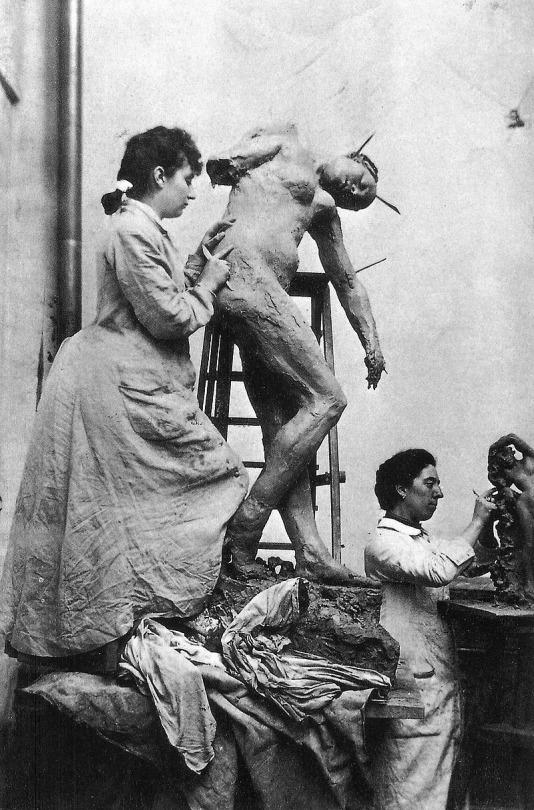
Camille Claudel œuvrant sur Sakountala, avec Jessie Lipscomb dans leur atelier rue Notre-Dame-des-Champs en 1887.
425 notes
·
View notes
Text
Louis XV's royal clutter

Castles opened to the public tend to put a great emphasis on furnitures, paintings and panellings. This focus often occurs at the expense of smaller every day items, such as tools, services, boxes and so on.
Even as far back as the 18th century, inventories of the garde meuble- the administration in charge of the French royal furnitures and collections- often omitted those smaller items, in favour of a greater focus on the furnitures themselves.
Several exception that that rule do exist for instance : When King Louis XV died the 10th of May 1774 in Versailles, his Versailles private cabinets were opened and searched, all the cash and the precious items contained in his cupboards were listed and described in an inventory made 27 days after his death.
Said inventory isn't located in the documents of the House of King(O1 series of the french national archives) like it is usually the case, but in the King's papers, namely in the K series of the national archives, more specifically the K 153.
The document in question was never published nor translated to this date.
I decided to publish it for the first time and translate it entirely to give an idea of the of the kind of clutter that was present in the king's private cabinets in Versailles at the time of his death :
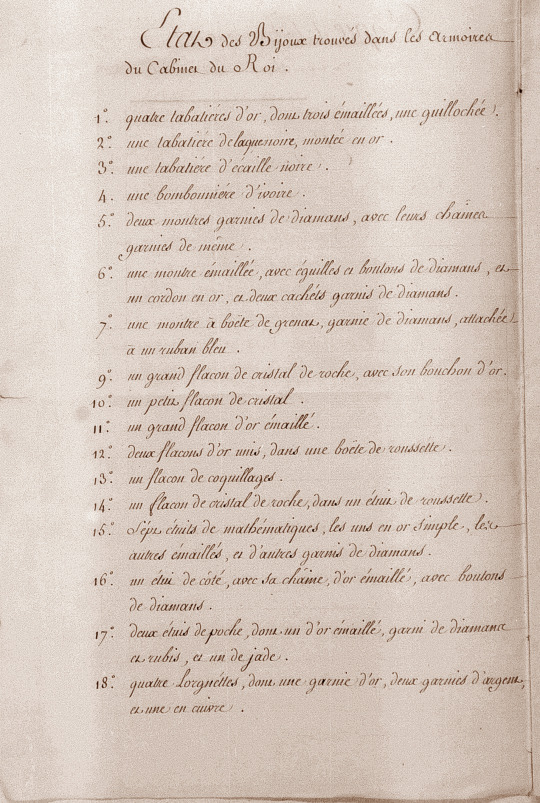
Here is the translation of the provided text into English:
1: Four gold snuffboxes, three enameled, one guilloché,
2: A black lacquer snuffbox mounted in gold,
3: A snuffbox of black tortoiseshell.
4: An ivory candy box.
5: Two watches encrusted with diamonds with their chains also adorned with diamonds
6: An enameled watch with diamond hands and button, a gold cord, and two seals encrusted with diamonds,
7: A garnet box watch adorned with diamonds, attached with a blue ribbon,
9: A large rock crystal flask with a gold stopper, and two seals encrusted with diamonds
10: A small crystal flask
11: A large enameled gold flask
12: Two plain gold flasks in a roussette box
13: A shell flask
14: A rock crystal flask in a roussette case
15: Seven math instrument cases, some in plain gold, others enameled, and some encrusted with diamonds
16: A side case with an enameled gold chain but with diamond buttons
17: Two pocket cases, one enameled gold adorned with diamonds and rubies, and one in jade
18: Four lorgnettes - two in gold, two in silver, and one in copper

19: Two pencil cases, one enameled gold adorned with diamonds, the other containing a compass
20: A Baradel in gold
21: A small portable silver barometer
22: Four tablets in gold, lacquer, or Burgos, one of tortoiseshell with diamond cyphers
23: Three souvenirs, one of enameled gold
24: A hunting knife with a gold handle
25: A dog collar with diamond initials.
26: A large lacquer tablet containing eight portraits of the royal family adorned in gold
27: A lacquer tablet with a portrait inside
28: Four portraits in three plain boxes
29: An ivory barrel adorned with gold
30: A piece of jade from the Amazon River
31: A Sèvres porcelain lorgnette
32: A gold and Magellan telescope
33: A porcelain Sèvres eyewash basin
34: A small red leather writing set adorned with gold, with a gold seal and pencil
35: A damask pruning knife
36: A double-bladed mother-of-pearl knife with a gold fleur-de-lys
37: Three glasses cases, one of tortoiseshell adorned with gold
38: An approaching eyeglass adorned with silver
39: A watch with its chain and seals, all in rubies and diamonds
41: A mathematics case in yellow lacquer with diamond buttons

42: Two almanacs mounted in silver and marcasites in their roussette cases
45: Three seals, two in gold, one in stone
47: Four rings, three with diamonds or coloured stones, one with an engraved stone
48: An English lorgnette
49: Four canes - one with a gold handle, one with a porcelain crutch, one with a gold apple adorned with diamonds, one with a golden apple-wood handle and parasol
50: Six watches - one in gold, enameled with a steel chain and chime, two other enameled, three other guilloché gold
51: A steel mirror
52: A gold egg cup in a roussette case
53: A gold writing set with Charlier paintings, in miniature in a roussette case
54: A very beautiful crystal vase, measuring 9 inches in height
55: A gold breakfast set consisting of a Sevres porcelain tray, two identical cups, a gold teapot and sugar pot, two spoons, a strainer, and a sugar tong made of the same metal
56: A gold-enameled punch pot with a pump, and a second pot of Saxony porcelain
57: A small enameled gold punch pot with a pump and a crystal basin
58: Two gold-enameled candlesticks with their bobeches
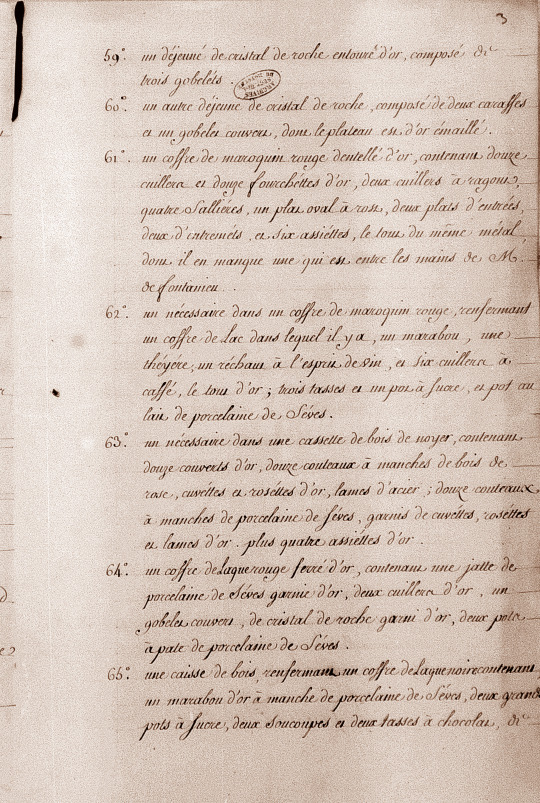
59: A crystal breakfast set surrounded by gold, consisting of three goblets
60: Another crystal breakfast set consisting of two carafes and a covered goblet, with the tray of enameled gold
61: A red leather box, edged with gold, containing 12 gold spoons and 12 gold forks, two roast oval plates, two appetizer plates, two dessert plates, and six dishes, all made of the same metal, with one missing, which is in the possession of Mr. de Fontanieu.
62: A set in a red leather box containing a lacquer box with a marabout, a teapot, a spirit lamp, six coffee spoons, all made of gold, three cups, a sugar pot, and a milk jug made of Sevres porcelain
63: A set in a walnut wood box containing 12 gold tableware, twelve knives with rosewood handles, gold cup and rosette, steel blades, twelve knives with Sevres porcelain handles adorned with cup rosette landau, plus four gold plates
64: A red lacquer box reinforced with gold, containing a Sevres porcelain bowl adorned with gold, two gold spoons, a covered crystal goblet adorned with gold, two porcelain pasta pots from Sevres
65: A wooden case enclosed in a black lacquer box containing a marabout made of gold with handles made of Sevres porcelain, two large sugar pots, two saucers, and two chocolate cups made of porcelain, a spirit lamp, adorned with gold, a square crystal flask adorned with gold, two coffee spoons, and a large gold spoon

66: A gold-plated copper microscope in its pyramid case
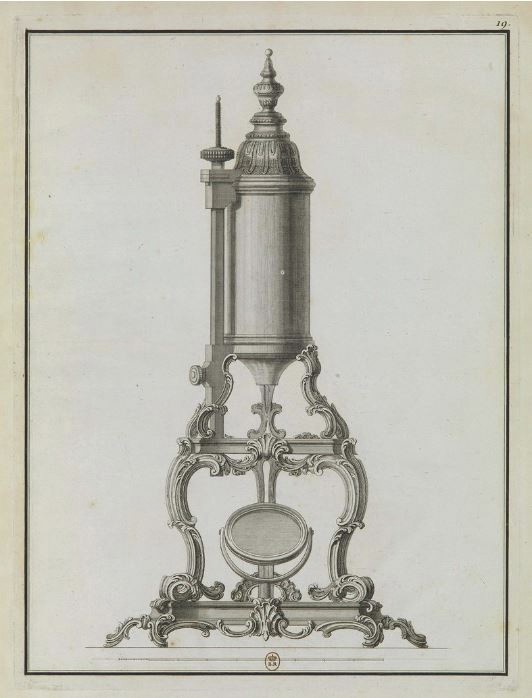
Dom Noël, Planche 19 Microscope tripode.
67: A writing set with 12 zodiac signs
68: A wooden box reinforced with silver containing a pharmacy adorned with silver
69: A yellow lacquer box enclosed in a red leather box
70: A graphometer in a red leather case
71: A gold compass with its stand and a level in a sharkskin case
72: A black lacquer box
73: A breakfast set consisting of a painted sheet metal tray and two porcelain cups
74: A writing set made of silver-reinforced roussette
75: Supplementary gold tableware, three coffee spoons, one tea spoon, a gold set in a roussette case
76: A small black lacquer box
77: A small oak chest, we weren't able to find the key
78: A box of tools with wooden handles and silver ferrules
79: A box of Kingswood,but the key wasn't found
80: A gold-braided telescope
81: A coffee pot for four gold cups with jasper handles and six gold coffee spoons, in a leather case made to contain 12.
60 notes
·
View notes
Text
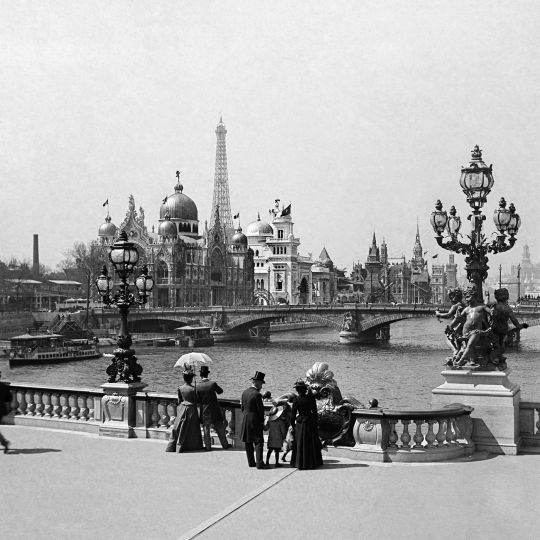
1900 Paris World's Fair.
Photo Léon & Lévy.
487 notes
·
View notes
Text

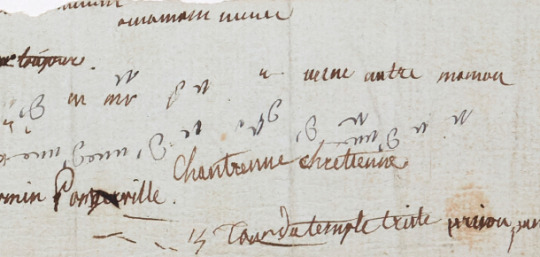
A scrap with random writing by Marie Thérèse Charlotte, daughter of Louis XVI and Marie Antoinette, while she was imprisoned in the Temple tower. The archive listing says circa 1792-1795; my guess would be after 1794, when she was given freer access to writing material again.
362 notes
·
View notes
Text

Nacelle of the Airship "La République"
French vintage postcard
34 notes
·
View notes
Text

Vacherie Saint-Christophe - Lait chaud matin et soir, Clamard, Hauts-de-Seine.
36 notes
·
View notes
Text
Sigh.
Heavy sigh.
I haven’t stated my thoughts on the movie trailer yet. Instead I have been watching different reaction trailers and reading articles and blurbs on it. Luckily I have not ventured into the dumpster fire that is Twitter and its reactions.
But it is frustrating. This article frustrates me. I have been studying Napoleon for (ahem 30+ years) and to say that Napoleon is too often portrayed is laughable. Why does that not feel so to the Napoleonic Community? Bill and Ted’s , Night At The Museum, doesn’t count in my book because Napoleon is basically charactured.
I am not here to argue Napoleon was a saint, he was not. I am not even interested in that debate anymore as it’s been done to death. But I am also alarmed, as a history geek and as a historian, of this movement that we should only study those who are deemed “good” by society’s whims at the given moment. From some of the reactions (or over reactions) that seems to be somewhat what I hear. Or jealousy that your favorite historical whoever has not yet had a film dedicated to them. I know, it sucks and is frustrating. Napoleon scholars can sympathize.
What is also slightly amusing to jarring is the armchair commentators who know “something” but often by their commentary show they know nothing. The video yesterday I posted of the two historians commenting, albeit in pro British ways, were talking about how they knew nothing of the Survivor’s Balls that happened after the Terror. That women would cut their hair short and wear a red ribbon around their neck. This all goes to prove I guess that even the big not so accurate Hollywood movies can have their teachable moments. The Napoleonic period of course is so wide that historians focus on different areas to study and concentrate on too. Josephine isn’t an unknown character, like these commentators seemed to be suggesting, they just haven’t picked up a biography on her or turned their eye to that part of Napoleonic history.
I will close with this last example. I was watching a reaction video to the trailer where when the Egyptian scene came on the person shook their head in disgust. Afterwards they said with all the authority that their know-how afforded them: “So let me say, Napoleon was a racist. Okay? I know that. That is why he shot at the pyramids. That is why he shot the nose off the Sphinx. It had an African face with African features and he destroyed it because he hated it. “
Sigh. Okay. I get that you want to be outraged at Napoleon for political points, but at least be outraged at things he actually did, and there are a few, than made up things you have read from questionable sources. Point one, Napoleon did not shoot at the Pyramids. He did make his way to them eventually but the Battle of the Pyramids happened miles away from the location where they stand. About three hour walk or so. The Pyramids were not shot at for target practice or because Napoleon and the French Army found them repulsive. Second, Napoleon had nothing, absolutely nothing, to do with Sphinx’s nose. Theory holds that ancient statues, ancient even in Napoleon’s time, weaken and one of the first places they start to crumble is in the nasal area. Napoleon did not shoot the nose off personally because he was a racist mofo who saw the Sphinx and it made him mad because it had Egyptian features.
These are teachable moments but it would be nice before you get riled up or get your viewers riled up, you at least had accurate history. Here is what Napoleon did do in Egypt…he brought along scholars and artists and they discovered new species (to them) and new art (to them) and discovered and little old thing called the Rosetta Stone that helped crack hyroglyphics. Did they loot? You bet. Did they take off with things? Sure did. That you can debate on, but not shooting the nose off the Sphinx.
#sigh#note to myself: don't watch reaction videos about Napoléon#even more if its from a movie#why some peoples are so proud to show they are stupid ?
70 notes
·
View notes

